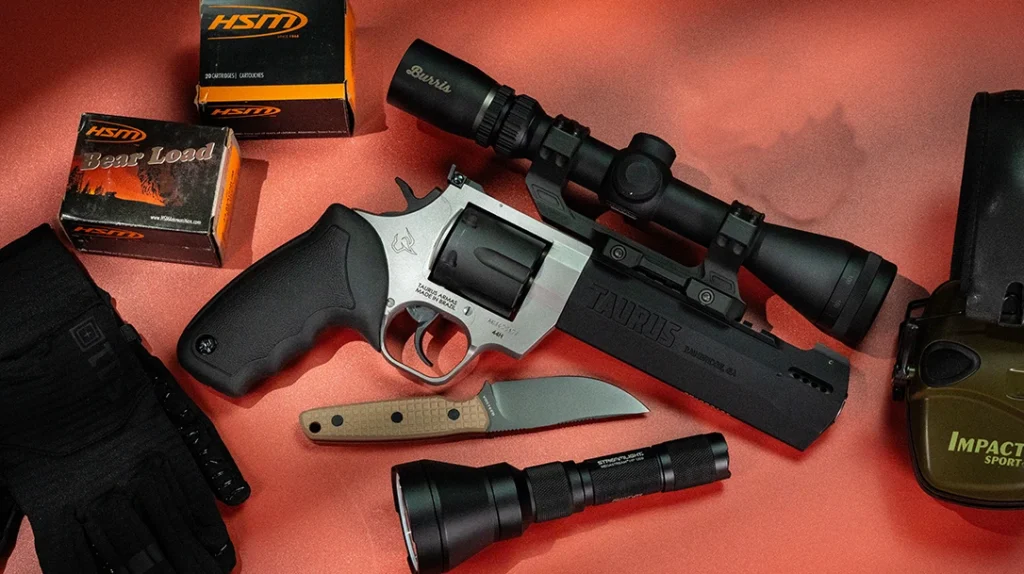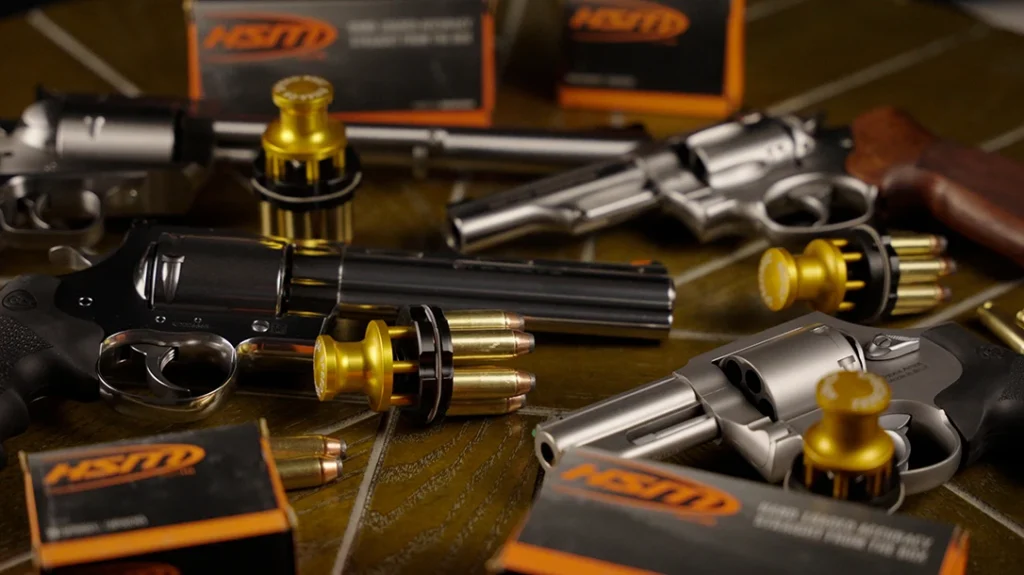What comes to mind when J.P. Sauer & Sohn (Sauer) is mentioned? Old World craftsmanship and a matching price tag are two immediate thoughts. After all, Sauer has the distinction of being the oldest active firearm manufacturer in Germany. They have been in business since 1751, well before the colonies even thought about going their own way from Great Britain. You would be right in saying that Sauer certainly offers high-end, refined weapons. Sauer’s corporate leadership has decided to up the ante with the recently introduced Sauer 505 bolt action.

The J.P. Sauer & Sohn 505 – Bolt Action Ingenuity
With the Sauer 505, J.P. Sauer aimed to create the best bolt-action hunting rifle. Period. Many unique features are included. Several Sauer 505 models are available, each with a designation based on the chosen stock options. I had the opportunity to handle the Sauer 505 Synchro XT for this review. Its synthetic thumbhole stock visually dominates the Synchro XT. Inside the two-piece stock is a modular chassis system centered around the all-steel skeletonized 505 action/receiver.
First impressions are everything, and a first glance tells you the Sauer 505 is European. This is definitely confirmed when handling the design and getting into the details. Why is that? The European market has different driving forces than the US market. The Sauer 505 shows that there are different ways to do both chassis and modular rifles gracefully. Definitely a European thing where buying one rifle can unlock different calibers and uses. Due to firearm regulations, this is a real plus and easier than buying multiple rifles, as we would just do here in the US.
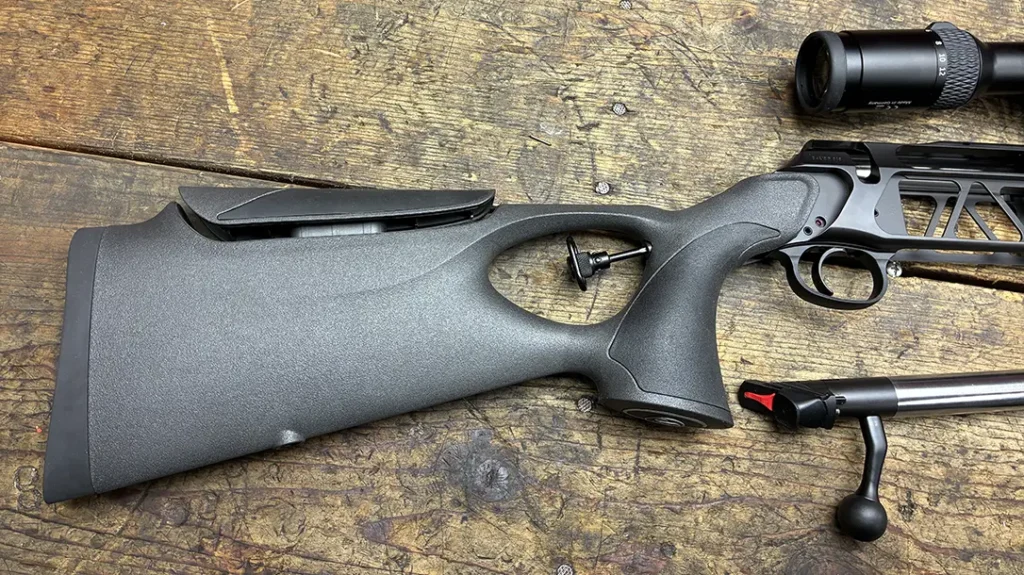
Advertisement — Continue Reading Below
Separate Stock Furniture
The stock furniture consists of a separate buttstock and forend sandwiching the receiver. This is done so well that you can almost mistake it for a typical all-in-one stock. A single hex screw attaches the buttstock, and the forend is attached by a latch that clamps onto a spigot protruding from the action. At no point does the forend contact the barrel.
Eight different stock options, featuring materials such as high-grade walnut, polymer, and carbon fiber, with 19 chamberings and numerous barrel profiles and lengths, are currently available in the Sauer 505 catalog.
All are configurable in the field with a 4MM Allen Wrench that travels with the rifle, discreetly concealed under the rifle’s QD sling swivel stud. This enables changing out barrels and stocks. There is even an integrally suppressed barrel alternate available. Those crafty, detailed Germans think of everything.
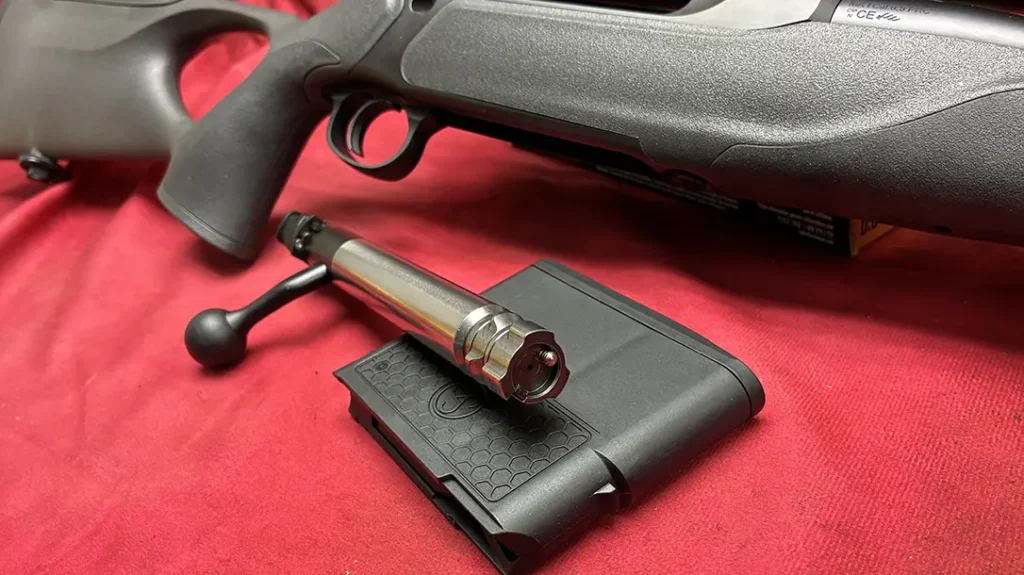
One Piece Steel Bolt
The Sauer 505 bolt is a one-piece steel bolt with a full diameter for extremely smooth passage and no wiggle inside the receiver. Unlike its Sauer 404 predecessor, the Sauer 505’s bolt head is not adaptable if the barrel chosen utilizes a different casehead dimension. If your cartridge swap involves a different casehead dimension, another bolt must be accessed from Sauer. Believe it or not, this is actually a cost-saving measure requiring less engineering and manufacturing expense.
Advertisement — Continue Reading Below
The Sauer 505 bolt is a six-lug design that interfaces directly with the barrel. The Sauer 505 bolt is not only buttery smooth…. but damn near impossible to bind/jam since the diameter matches the raceway path. One finger manipulation, racking violently, rapidly, and/or in haste, will cause no issue. The tapered bolt handle starts pulling brass from the chamber on the handle’s upswept motion. The best anecdote I can offer about the bolt’s slickness is that, when first experiencing it on the bench, I had to keep checking whether a round was actually stripped from the detachable magazine and chambered. That is how smooth the Sauer 505 goes into and out of battery!
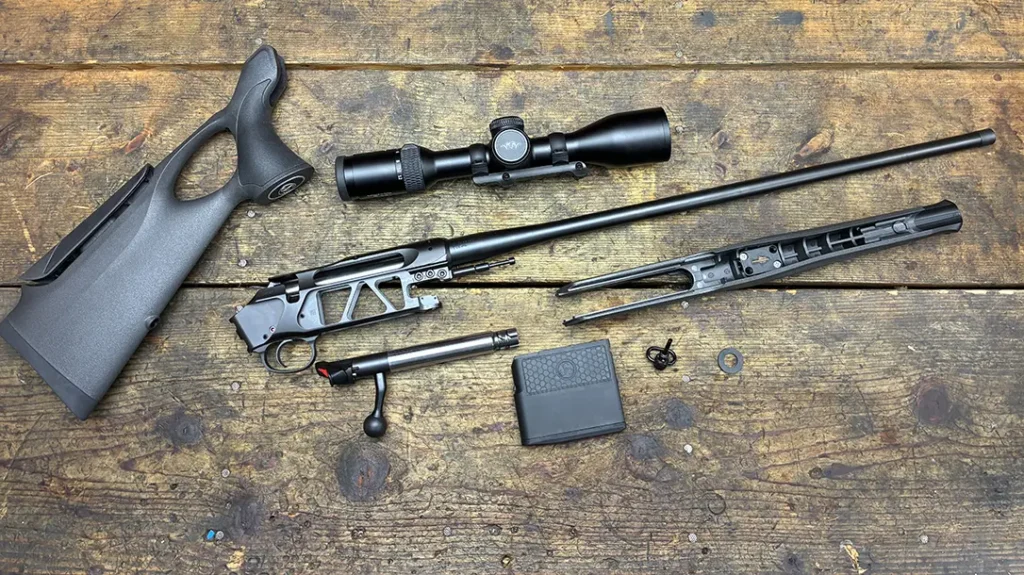
Single Stack Mags
Flush-fitting 3-round and 5-round single-stack detachable magazines are released by a spring-loaded button in front of the magazine under the forend. During research, I read about concerns of inadvertent dropping. This is deemed unfounded based on the distinct force and finger placement required to remove the magazine. Further insurance can be found via the button, which can be slid forward to lock it out.
Part of the Sauer 505’s unique design involves the safety methodology used. The safety is not so much of a mechanical block, but rather a sliding “actuator” button that you use to cock and de-cock the rifle. It is located at the rear end of the bolt. This allows the gun to be carried uncocked, eliminating the risk of negligent discharge if it is dropped or jarred. The button is pushed silently forward to cock the rifle when ready to fire. A raised red tactile tab appears when the rifle is cocked. This is very similar to the Blaser method I have used on their R93 and R8. This makes sense, given that Sauer became part of the Blaser Group in 2009.
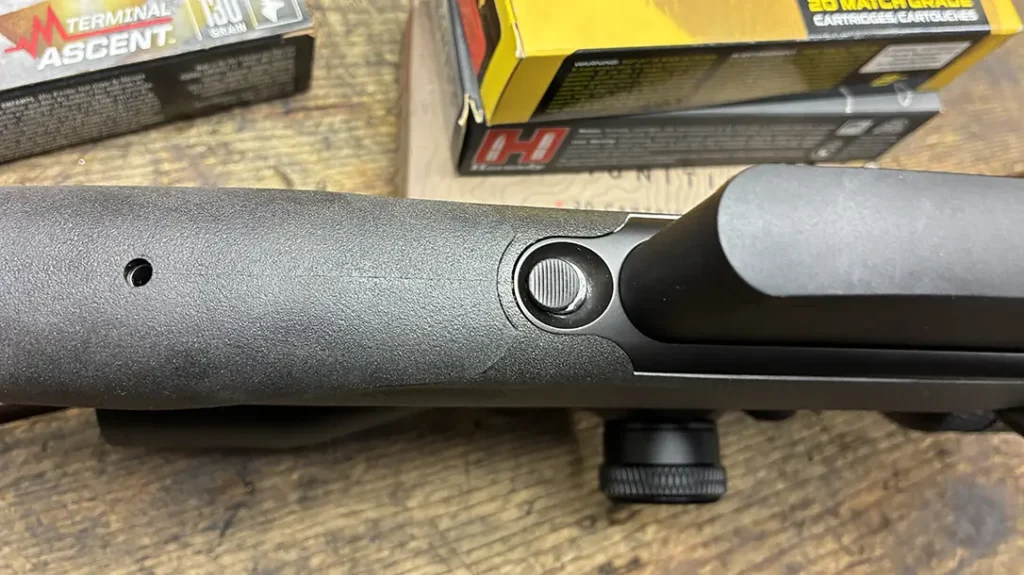
Advertisement — Continue Reading Below
Blaser Connection
Speaking of the Blaser connection. Some pundits theorize that the Sauer 505’s steel action, rather than the aluminum found on previous bolt-action models, was a nod to the one-piece Blaser saddle scope-mount system. A Blaser B2 2-12X50MM IC optic accompanied the Sauer 505. The Blaser optic and mounting method could spawn an article of their own. Blaser mounts their optics via recesses machined directly into the receiver, accepting a saddle scope mount. There is no need for a large optic base that can interfere with your sight picture or the aesthetics of the rifle.
Manipulating/rotating two small levers on the Blaser mount is all that is needed to mount/remove the optic. This was done multiple times. Scope zero stayed put. I can only imagine the machining tolerances that need to be maintained with the receiver, mounting indentations, and Blaser mount to ensure proper connection. This encapsulates the entire Sauer 505 experience in a nutshell.
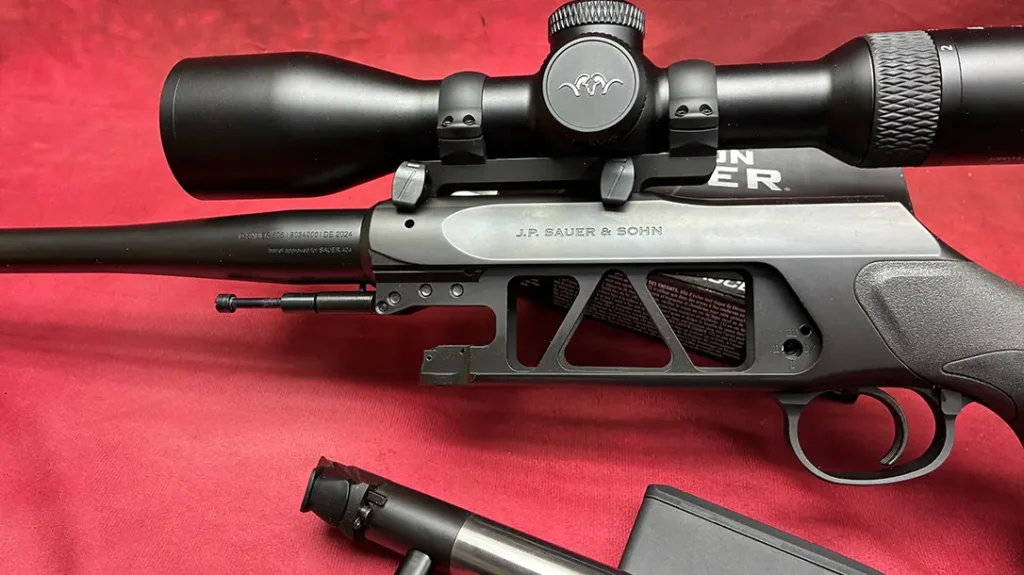
Quattro Trigger
The Sauer Quattro trigger wraps up the Teutonic flair with the Sauer 505. It’s four settings, Quattro Trigger…get it…are user-adjustable with the aforementioned 4MM Allen wrench. Pull weights are 0.77, 1.66, 2.20, and 2.75 pounds. It is a work of art. No creep, overtravel, or anything else besides a damn near perfect interface between weapon and user.
A Sauer 505 bolt action can morph into multiple rifles, hunting wild boar in the German forest, fallow deer on a French estate, chasing Ibex in Spain, and then be reconfigured into an African safari rifle the next week. Calibers range from .222 Rem to .375 H&H. Our Sauer 505 Synchro XT arrived chambered in the very American 6.5 PRC. oMudularity With Flair
Advertisement — Continue Reading Below
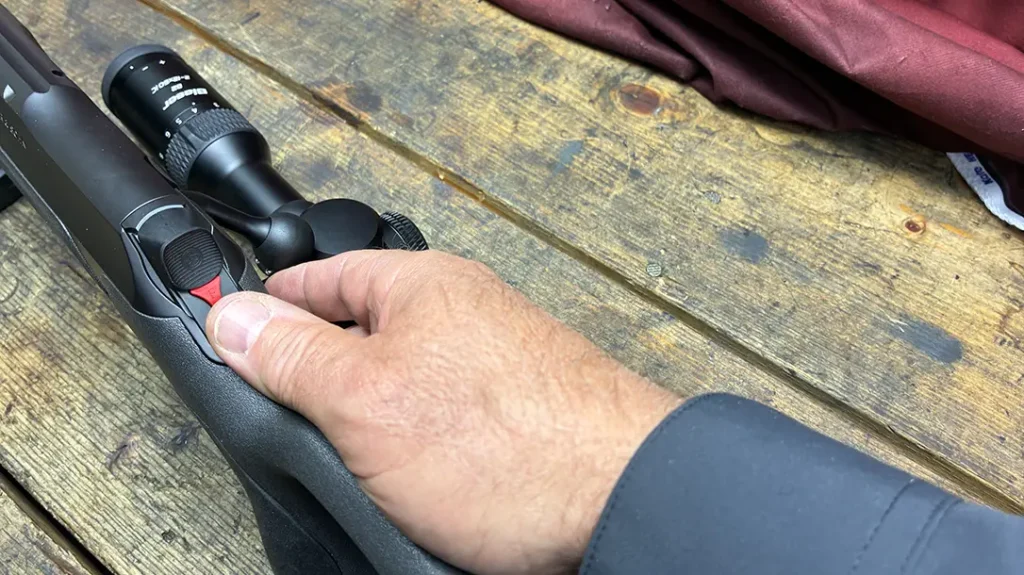
Modularity With Flair
Hornady created the 6.5 PRC from the .300 Ruger Compact Magnum as the parent case. The cartridge was unveiled at the 2018 SHOT Show. The 6.5 PRC is a perfect combination of ballistic performance and recoil. 6.5 PRC factory loads fire the same bullet, 250-300 fps faster than the 6.5 Creedmoor. Therefore, 6.5PRC has a flatter trajectory, more retained energy, and less wind drift than the 6.5Creedmoor.
Typical 6.5PRC ballistics from a 26-inch barrel are a 143-grain bullet at 2,960fps or a 147-grain bullet at 2,910fps. Nice that 6.5PRC is catching on with other manufacturers offering loads besides Hornady, such as Federal and Berger. Federal and Berger are offering loads beyond the stalwart Hornady 143-grain ELD-X. Federal the 130-grain Terminal Ascent and Berger the 140-grain and 156-grain Elite Hunter bullets. Hornady’s Outfitter 130-grain CX is another noteworthy addition.
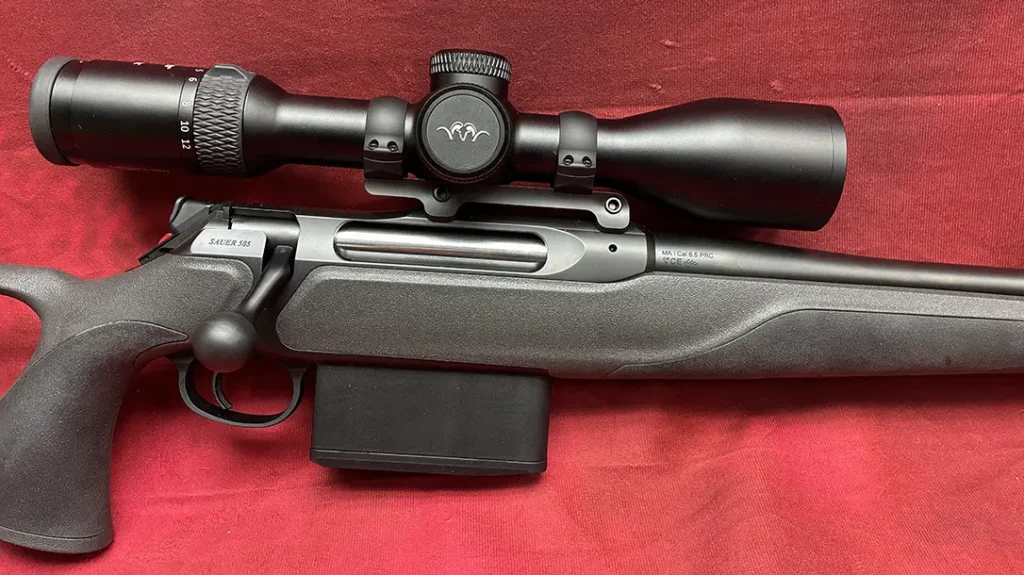
Thumbhole Stock
The Sauer 505 Synchro XT with a thumbhole stock, adjustable cheekpiece, and distinctive Schnabel forend weighs 8.5 pounds and measures 44.25 inches overall, featuring a 1:8 twist, cold-hammer forged, 24-inch threaded barrel. I came to appreciate the thumbhole stock. The Sauer 505 stock options are as modular as the caliber flexibility. Sauer offers more traditional stock patterns as well, not to mention some with luxurious wood patterns.
Advertisement — Continue Reading Below
Several visits to the Echo Valley Training Center (EVTC) with the Sauer 505 Synchro XT with thumbhole stock solidified appreciation of what the rifle has to offer. I wanted to spend as much time as possible with this heirloom-grade rifle. The rifle’s buttstock sacrificed nothing in terms of performance, proving easily adaptable for bench and prone shooting, riding support bags well. Importantly, the rifle excelled at offhand shooting. An important consideration for hunters in fluid field conditions. Bolt manipulation was smooth and quick.

Bench Testing
After bench testing, the fun began with the Sauer 505 through various T&E scenarios. This consisted of shooting prone off a pack at clay pigeons at 300 yards. I worked the bolt and acquired the next target as quickly as possible. The ergonomic stock, optic clarity, premium ammunition, and slick bolt proved potent. Other range work consisted of shooting 8-inch round steel poppers out to 525 yards on EVTC’s Known Distance Range. Initial bench accuracy results at 100 yards showed the modular Sauer 505 capable of MOA accuracy. The Sauer 505’s accuracy, combined with 6.5 PRC ballistics and a Blaser optic, made hits seem easy even at this distance.
The EVTC Jungle Walk Range was used to get a sense of handling. Targets were set up randomly along the meandering 775 yards. Unconventional braced field positions were assumed to take advantage of a fallen tree or handy limb for support. The thumbhole stock offers superior manipulation, think pistol grip of an MSR, by seating the heel of the hand much better for fluid shots, especially hurried ones.
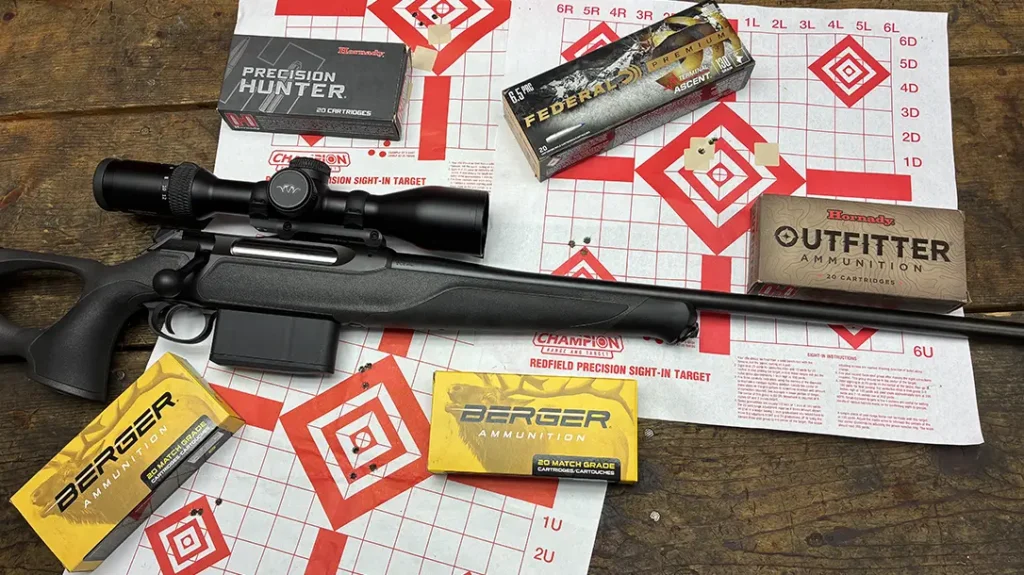
Advertisement — Continue Reading Below
Reduced Weight
The Schnabel-like forend reduces the stock’s overall weight, and more importantly, its thinner profile towards the front is ergonomically beneficial, providing a good reference point for your forward hand when shouldering the rifle. The Schnabel forend is a European design feature often found on over/unders and lightweight bolt actions—both of which pursue fleeting game, albeit bird taking off or boar busting from cover. The Sauer 505 proved easy to handle, with no searching for the target required when brought to the shoulder.
Sauer has raised the bar with the Sauer 505, its simple yet ingenious modularity maintaining European panache and flair. Yes, some of the Sauer 505 models can climb into the $6,000 price range. However, the Sauer 505 Synchro XT can be found listed at $2,900 online. Yes, that is more than your typical bolt action, but frankly, more and more of our mid-to-upper range US-made bolt actions ring in at $2,500+ as well.
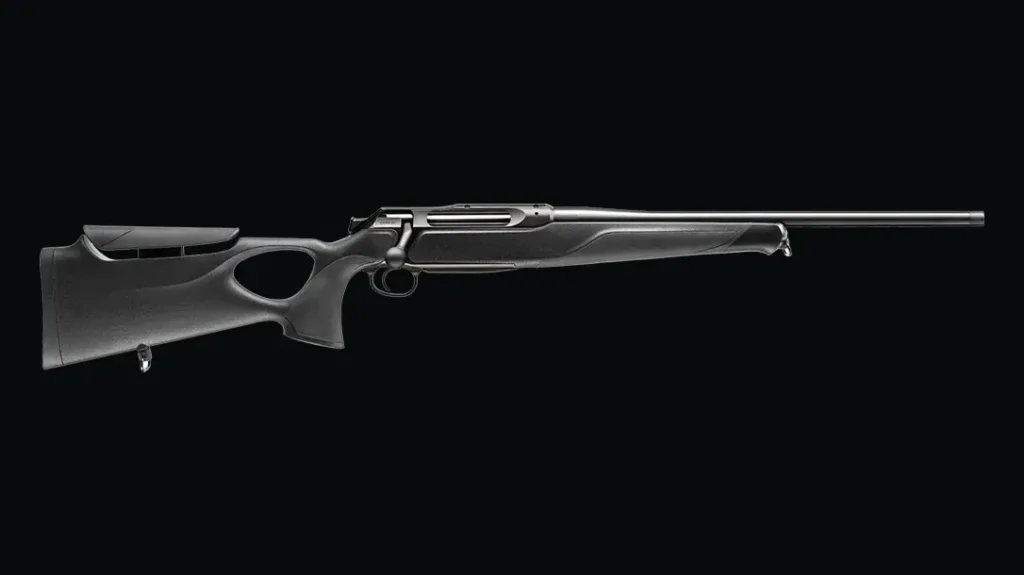
The J.P. Sauer & Sohn 505
Rather than focusing solely on cost, it is important to acknowledge the ingenuity, engineering, and commitment that went into developing the Sauer 505. While not suggesting that the Sauer 505 renders US bolt-action rifles obsolete or is inherently superior, Sauer’s methodology deserves recognition and respect for its unique approach.
Certainly, it is nice to get a different perspective from Old World craftsmen who spare no expense or effort to put their vision of the Sauer 505 into operation. Let’s appreciate the ingenuity, engineering, attention to detail, and dedication it took to create the Sauer 505 together.
Advertisement — Continue Reading Below
For more information, visit J.P. Sauer & Sohn
.
SPECIFICATIONS: J.P. Sauer & Sohn Sauer 505 Synchro XT
| CALIBER: | 6.5 PRC (numerous other calibers also available) |
| BARREL: | BSF 24-inch threaded (1/2×28) hammer forged 1:8 RH twist |
| OA LENGTH: | 44.25 inches |
| WEIGHT: | 8.5 pounds |
| ACTION: | Sauer 505 bolt action |
| CAPACITY: | Detachable 5-round magazine arrives with the rifle |
| PRICE: | $3500 MSRP |
Performance
Advertisement — Continue Reading Below
| Round | Avg. FPS | Avg. -3 Shot Group |
| Hornady 143gr ELD-X | 2891 | .875 |
| Hornady 130gr CX | 2916 | 1.2 |
| Berger 140gr Elite Hunter | 2811 | .912 |
| Federal 130gr Terminal Ascent | 2877 | 1.0 |
Three 3-rd groups fired 100 yards/Garmin Xero C1 Pro chronograph.
WHY OUR ARTICLES/REVIEWS DO NOT HAVE AFFILIATE LINKS
Affiliate links create a financial incentive for writers to promote certain products, which can lead to biased recommendations. This blurs the line between genuine advice and marketing, reducing trust in the content.

